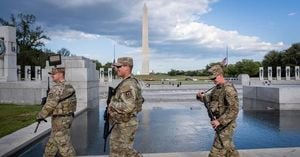As the school year kicks into high gear across the Midwest, communities are facing a double-edged challenge: keeping students and families healthy amid the persistent threat of COVID-19, while also tackling a surge in the consumption of energy drinks among teenagers. Both issues, though distinct, are shaping the way schools, parents, and local organizations approach safety and well-being as September unfolds.
On September 3, 2025, health experts renewed their calls for basic but effective precautions to limit the spread of COVID-19. According to El Dorado Springs Sun, the advice remains familiar: frequent hand washing, staying home when sick, and avoiding close contact with anyone showing symptoms. Yet, the need for vigilance is as urgent as ever, especially as students return to classrooms and fall activities ramp up.
Schools and local organizations have rolled out a suite of measures to reduce exposure as the academic year begins. From staggered schedules and enhanced cleaning routines to reminders about personal hygiene, the aim is to keep classrooms safe and limit disruptions to learning. "Protecting children, older adults, and those with underlying health conditions is especially important," health experts emphasized, as even mild cases can upend household routines, workplace schedules, and community events.
Maintaining clean surfaces, practicing consistent hygiene, and encouraging healthy habits have become practical steps communities are taking to reduce the risk of illness. Experts note that awareness of local case trends and mindfulness about shared environments—homes, schools, workplaces, and even vehicles—can further limit exposure. After all, viruses and other pathogens can linger on surfaces and in the air, adding to the risk of transmission in everyday life.
Environmental precautions are getting a boost as well. Integrity Pest Solutions, a local business, has begun offering Electrostatic Disinfection services in homes, businesses, and vehicles. This technology aims to reduce pathogens from both surfaces and the air, providing what the company calls "an added layer of protection" during the ongoing presence of COVID-19. While not a silver bullet, such environmental measures, when combined with personal precautions, "contribute significantly to reducing illness and disruption," according to Integrity Pest Solutions.
"These measures are especially valuable in areas where many people gather and interact regularly," the company explained. Schools, workplaces, and public spaces all benefit when communities take these steps together. The message is clear: staying vigilant, maintaining good hygiene, and taking practical environmental measures remain key as the school year continues. These efforts, experts say, help limit the impact of COVID-19, protect vulnerable populations, and keep shared spaces safer for everyone.
But public health isn’t just about viruses. In Independence, Iowa, a new concern has landed squarely on the desks of school officials: the skyrocketing popularity of energy drinks among teenagers. The Independence Community School District recently announced new restrictions on students drinking energy drinks at school, following an uptick in students consuming multiple cans each day. The district posted the policy change on Facebook, citing worries that the drinks are "detrimental to a student’s health and ability to focus," according to KCRG.
Dr. Ryan Sundermann, emergency room medical director at UnityPoint St. Luke’s Hospital in Cedar Rapids, weighed in on the trend. "If you consume too much caffeine, it can cause a lot of excitation, agitation. It can cause your heart rate to go really fast," Dr. Sundermann explained. While he acknowledged that, "in and of itself, in an otherwise young and healthy person, it’s not going to probably do any real permanent damage," the short-term effects can be disruptive and concerning.
The numbers back up the district’s concerns. About a third of children aged 12 to 17 now regularly consume caffeinated energy drinks, a statistic that has health officials and educators alike on alert. The drinks, often packed with sugar and high doses of caffeine, promise a quick energy boost—but the side effects can include jitteriness, trouble concentrating, and, in some cases, heart palpitations.
Not everyone is on board with the new restrictions. TV9 reporters from KCRG spoke with several high school students in Cedar Rapids who offered a range of perspectives. Keke White, a student at Washington High School, said, "It helps me like be energized to do my work." When asked how she would respond if her school banned energy drinks, White was frank: "I’m going to still sneak it in. Like they can’t stop me." Her classmate Aryonna Thomsen added, "I’m going to drink one before I come to school then. Because I need that energy from my energy drink."
Other students took a more measured view, suggesting that self-regulation should be the norm. "It’s not really like bad, it’s an energy drink. They know what they’re doing by drinking that. What they’re putting their life at risk. They can see all that information on the internet," said Janissa Pledge, also a student at Washington High School. The debate highlights a generational divide—and perhaps a broader cultural question—about where personal responsibility ends and institutional oversight begins.
For school administrators, the issue is more than just a matter of preference. The district’s decision to send students to the nurse if they’re seen with an energy drink reflects a growing consensus among educators that excessive caffeine consumption can interfere with learning, sleep, and overall well-being. The hope is that by curbing access during school hours, students will be less likely to overindulge—and more likely to stay focused in class.
Meanwhile, the push for better hygiene and environmental safety continues to intersect with daily routines in classrooms, cafeterias, and extracurricular activities. The ongoing presence of COVID-19 means that every cough, sneeze, or sniffle is met with heightened awareness. Teachers, parents, and students are all adjusting to a "new normal" that requires flexibility, patience, and a willingness to adapt.
Some families are taking matters into their own hands by investing in enhanced cleaning protocols at home and in their vehicles. Businesses like Integrity Pest Solutions report increased interest in services like Electrostatic Disinfection, which promise to reduce not just COVID-19, but a broad range of pathogens that can disrupt daily life. The emphasis, experts say, should be on layering precautions: combining personal habits like hand washing and staying home when sick with environmental interventions that target germs in shared spaces.
As September unfolds, the message from health professionals and educators is unmistakable: community health is a team effort. Whether it’s limiting the spread of COVID-19 through vigilant hygiene and environmental cleaning, or tackling the less visible but no less real risks of excessive caffeine consumption, the choices made by individuals ripple outward to affect everyone. The stakes are high—but so is the potential for positive change when communities pull together.
The start of the school year always brings its share of challenges, but with renewed attention to both personal health and collective responsibility, there’s reason for cautious optimism. By staying alert, making informed choices, and supporting one another, schools and families can navigate the months ahead with resilience and resolve.



